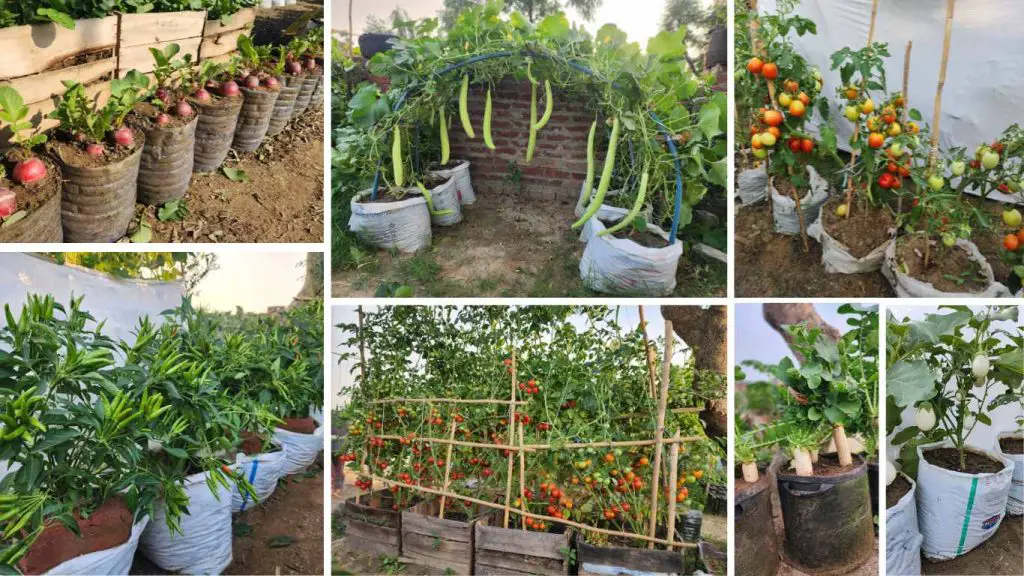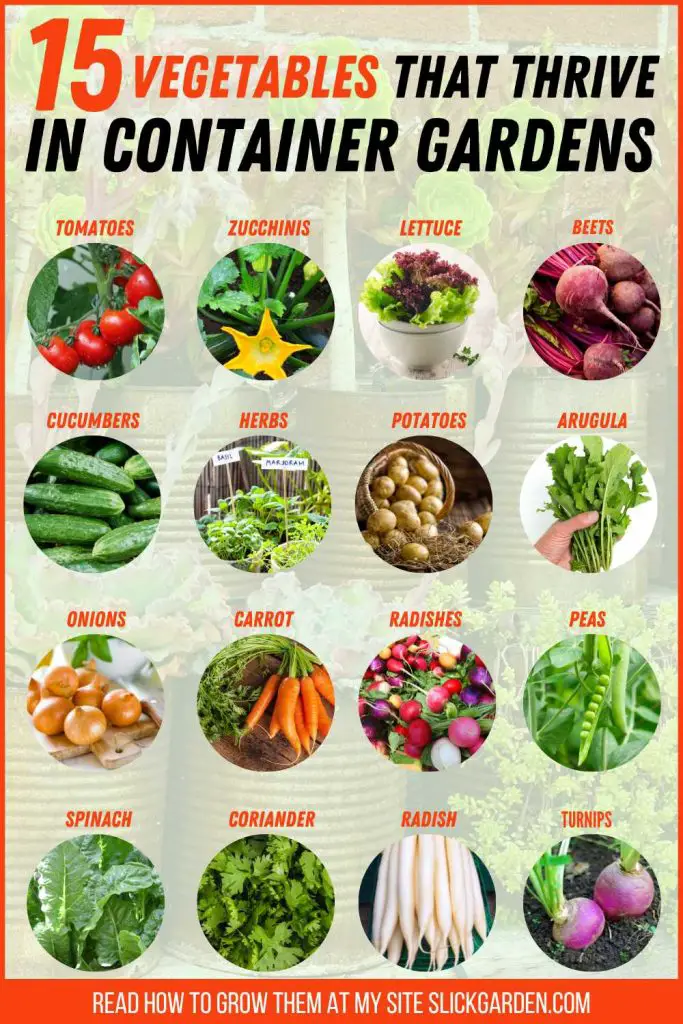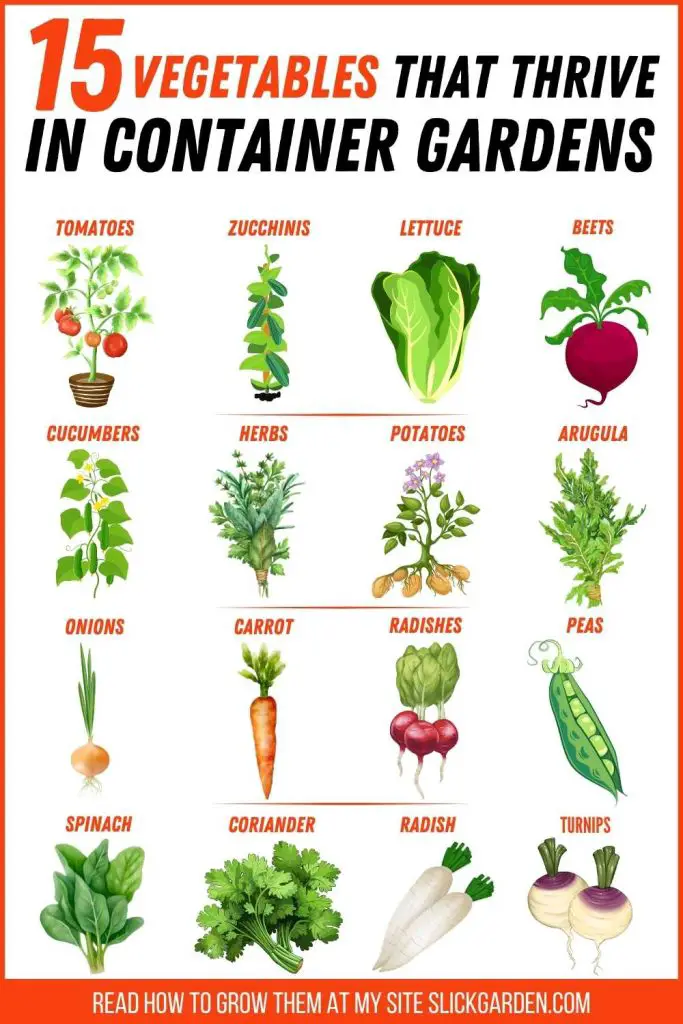To grow hearty vegetables, you don’t need a big yard or raised beds. People who don’t have much room or who want to start slowly to see if gardening is something they want to keep up with can grow a garden in a container.

We have the list for you whether you want the vegetables that grow the fastest or the ones that take the most time and last all year. You can plant any of these 15 easy-to-grow vegetables in a pot or anywhere else.
1. Carrots
Carrots may thrive in container gardens with proper upkeep and care. Select receptacles large enough to accommodate the carrot’s lengthy taproot, ideally one that is at least 12 inches deep.
Make sure the container has adequate drainage to prevent waterlogging, which can lead to decay. Pick a well-draining, loose potting mix that is rich in organic matter.
Plant the carrot seeds directly in the container, separating them by two to three inches, or as the cultivator recommends. Don’t overwater carrots because they can split or become deformed if the soil isn’t regularly moistened. Thinning out seedlings as they grow will allow each one enough space to develop fully and prevent overcrowding.
Carrots prefer full sun, so place the container somewhere that receives at least 6 to 8 hours of sunlight per day. They can tolerate some shade, though. Aphids, slugs, and carrot rust flies are examples of pests to watch out for and take appropriate action against.

2. Cucumbers
Cucumbers grow well in container gardens if the right conditions are met:
Select a sizable container with adequate drainage to prevent waterlogging. The ideal container for cucumber growth is one that is at least 18 inches wide and deep.
Set up the container so that it receives six to eight hours of sunlight each day. Cucumbers need lots of sunlight to grow and produce fruit.
Support: Cucumbers need a cage, trellis, or stake because they are climbing plants. This promotes their upward growth, preserves space, and stops fruit from rotting on the ground.
When watering, make sure the ground is consistently moist but not drenched. Water deeply when the top inch of soil appears dry, especially during warm weather.
Fertilization: Apply a balanced fertilizer or an organic compost on a regular basis to encourage fruit production and healthy development.
Cucumbers may need assistance from other plants if they are grown indoors or in a protected area. Use a tiny brush or give the plants a little shake to transfer pollen from one flower to another.
3. Tomatoes
Tomatoes are a great option for container gardening because of their versatility and relatively compact growth. Growing tomatoes in pots offers many advantages, whether you’re a tiny space gardener or just want to spruce up your patio or balcony.
First off, since containers give you excellent control over soil quality, drainage, and moisture levels, you can create the perfect growing environment for your tomatoes.
Second, compared to tomatoes grown in the ground, tomatoes grown in containers are less vulnerable to soil-borne illnesses. This is particularly beneficial in the event that nematodes or other soil-borne pathogens are present in your garden soil.
Growing tomatoes in containers also makes upkeep and management easier. You can arrange the containers so that they receive as much sunlight as possible on your property, which will encourage fruit production and healthy growth.
4: Onions
Onions are a versatile food that can grow well in container gardens if given the proper care. A few key considerations are necessary for successful onion cultivation in containers.
First, choose a container that is at least 8 to 10 inches deep to give the onion’s root system enough room. In order to prevent waterlogging, which could lead to the roots decaying, make sure the container has drainage holes.
Select a potting mix that allows for good drainage and sufficient aeration to promote robust root growth. A mixture of garden soil, compost, and sand or perlite works well for onions planted in containers.
Plant onion sets or seedlings 4–6 inches apart, about 1 inch deep in the ground, to allow room for bulb development. Water the container frequently enough to keep the soil evenly moist but not soggy.
As onions require direct sunlight, place the container in a location that receives at least 6 to 8 hours of sunlight daily.
5: Swiss chard
Swiss chard is a versatile, nutrient-rich leafy green that thrives in container gardens, making it a fantastic choice for urban or space-constrained environments.
When grown in pots, Swiss chard prefers well-draining soil that has a lot of organic matter. A container that is deep enough—at least 8 to 10 inches—allows roots to grow properly. Ensure that the container receives 6 to 8 hours of sunlight per day; some shadow is acceptable in warmer climates.
Regular irrigation is essential to keeping the soil consistently moist but not drenched. Swiss chard is a year-round crop in many areas because it requires less maintenance and can tolerate lower temperatures.
To encourage continuous harvesting, harvest outer leaves on a regular basis while allowing inner leaves to grow. This not only prolongs the growing season but also encourages new growth.
6: Zucchini
Zucchini grow surprisingly quickly, making them excellent choices for container gardening. Their shallow root system and small size make them ideal for pots or containers.
Use a container that is at least 24 inches deep and wide to accommodate the zucchini’s roots and allow for adequate drainage.
Pick nutrient-rich potting soil, and make sure the container receives plenty of sunlight—six to eight hours a day is ideal. To keep the soil consistently moist but not drenched, frequent irrigation is necessary.
In order to promote healthy growth and copious harvests, fertilize the zucchini plants every two to three weeks during the growing season.
7: Kale
Because of its hardiness and compact growth habit, kale makes an excellent container plant.
Kale grows well in containers if it receives adequate sunlight, water, and nutrients. It is important to use a container that is at least 12 to 18 inches deep and wide enough to accommodate the kale’s root system. Select a high-quality, well-draining potting mix to ensure sufficient soil aeration and moisture retention.
It is recommended to position the container such that it receives a minimum of 6 to 8 hours of sunlight daily. To keep the soil consistently moist but not drenched, frequent irrigation is necessary.
If given the proper care and attention, kale can flourish in container gardens, bringing nutrients and freshness to your homegrown vegetables.
8: Herbs
Container gardens provide fresh flavors to people with little or no outdoor space by offering a flexible and easy way to grow herbs.
In container gardens, you can easily control factors like drainage, sunlight exposure, and soil quality. This regulation ensures the ideal growing conditions for herbs, allowing them to thrive.
Herbs typically require a lot of sunshine for healthy growth and flavor development. In sunny spots like patios, balconies, or window sills where they can receive the necessary sunlight without being shaded by other plants, herbs can be grown in container gardens.
By using container gardens, herbs can be grown vertically or in small spaces, making the most of the available space. This allows people to grow a wide variety of herbs in small spaces, which is especially helpful for those who live in cities or have limited gardening space.
9: Broccoli
Green beans, also known as snap beans or string beans, are a versatile vegetable that can thrive in container gardens with the correct care and attention.
When selecting a container, go for a large pot that is at least 8 to 12 inches deep to accommodate your green beans’ deep root systems. To prevent waterlogging, make sure the container has drainage holes.
Green beans require full sun to produce an abundant crop, so locate your container garden in a bright area. To provide essential nutrients for plants, fill the container with compost and well-draining potting soil before planting.
Plant the green bean seeds directly in the ground, leaving two to four inches between each one, and then gently cover them with soil. Keep the soil consistently moist, but do not overwater it as this could lead to root rot.
Fertilize your green beans with a balanced fertilizer on a regular basis to promote healthy growth and abundant yields.

10: Lettuce
Because lettuce is a versatile and easy vegetable to grow, container gardens are an excellent place for it. If you give your lettuce the right care, you can eat it straight off your patio or balcony.
Select a container that is at least 6 to 8 inches deep and has drainage holes to prevent waterlogging. To supply nutrients, fill the container with compost and soil that drains properly. Lettuce prefers cooler temperatures, so place the container in a partially shaded area during the summer.
Keep the soil consistently moist but not drenched by watering it often, particularly in the dry seasons.
If you give your container garden proper care, you can regularly harvest delicious lettuce from it.
11: Pepper
Pepper’s decorative qualities and culinary adaptability make them excellent accent plants for container gardens. When grown in pots, peppers do best in controlled environments with plenty of water, proper soil management, and sun exposure.
Selecting the right container is essential. Select pots with a minimum diameter of 12 to 18 inches and drainage holes to prevent waterlogging and encourage good root development. Select a potting mix that drains well and has been improved with compost to provide essential nutrients and promote root growth.
Ideally, peppers should receive six to eight hours of sunlight each day.
Apply a balanced liquid fertilizer to pepper plants every two to three weeks to encourage robust growth and abundant fruit production.
12: Garlic
Garlic is a versatile plant for those with limited outdoor space since it does grow well in container gardens.
Choose a container that is at least 12 inches deep to guarantee sufficient root development. A broader container will also give bulbs more space to grow.
Look for a soil that has plenty of organic matter, such as compost or aged manure, and that drains well. Garlic soil should have a pH of between 6.0 and 7.0.
13: Arugula
Arugula grows quickly and tastes spicy, making it a great plant for container gardens. Growing arugula in containers has several advantages.
It first makes it easier to control soil quality, drainage, and sunlight exposure—all of which are critical for arugula growth. Second, containers provide a controlled environment that lowers the risk of disease and vermin.
Sunshine: Set the container in a location where it will receive six to eight hours of direct sunlight every day.
When planting arugula in containers, choose a pot that is at least 6 to 8 inches deep to give the plant’s root system enough space.
14: Radish
Radishes are a great plant for container gardening and are suitable for small spaces and urban environments because of their small size and shallow root systems.
When growing radishes in pots, choose a pot that is at least 6 to 8 inches deep and make sure it has enough drainage to prevent waterlogging. Compost and soil that drains well can be used to supply nutrients and promote robust growth.
15: Eggplant
Select a container at least eighteen inches deep and wide to accommodate the eggplant’s extensive root system. Make sure the container has drainage holes to prevent waterlogging.
Use a potting mix that drains well and has a high organic matter content to provide essential nutrients and promote healthy growth. Place the container in a bright area where the eggplant will receive at least six to eight hours of sunlight per day.
Regular irrigation is necessary to keep the soil consistently moist but not drenched, particularly in hot weather.
